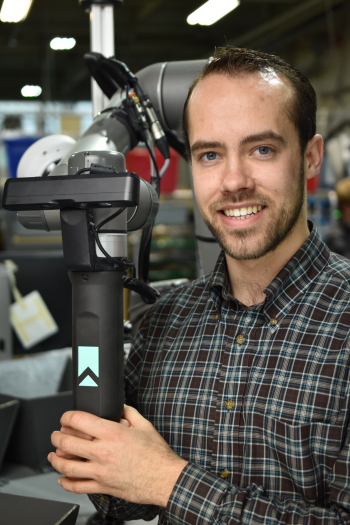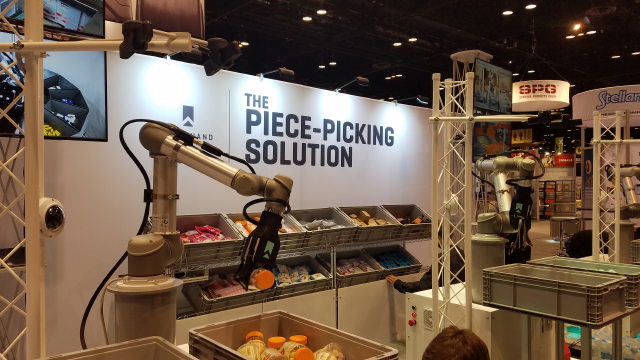With RightHand Robotics, this alumnus offers a novel piece-picking solution for e-commerce
Human beings are generally pretty good at grasping an item off a shelf; we can reach out and grab our favorite coffee mug just as the pot finishes percolating without giving the action a second thought.
For a robot, this seemingly simple action presents a plethora of complex challenges, from knowing what to grab (which mug?) to how to grasp it (squeeze the handle?)
RightHand Robotics, a startup co-founded by Leif Jentoft, S.M. ’13, Ph.D. ’14, is pioneering a hardware and software solution that gives robots the ability to automatically pick and grasp items with speed and judgment closer to that of a human worker.
 The company grew out of research conducted by Jentoft and his colleagues in the Harvard Biorobotics Laboratory, run by Rob Howe, Abbott and James Lawrence Professor of Engineering at the John A. Paulson School of Engineering and Applied Sciences (SEAS). Jentoft, who studied engineering sciences at SEAS, joined the lab because of his interest in developing technology to solve real-world problems.
The company grew out of research conducted by Jentoft and his colleagues in the Harvard Biorobotics Laboratory, run by Rob Howe, Abbott and James Lawrence Professor of Engineering at the John A. Paulson School of Engineering and Applied Sciences (SEAS). Jentoft, who studied engineering sciences at SEAS, joined the lab because of his interest in developing technology to solve real-world problems.
“Grasping is a very complicated problem. How do you make a robot that can grasp many different items it has never seen before?” he said. “The challenge is that every single item looks different, is shaped different, and feels different—there’s a lot of variation.”
Seeking a simpler solution than the expensive multi-motor robotic hands on the market, Jentoft and his collaborators designed a device that mimics the biomechanics of a human hand. This underactuated robotic hand used a single motor for several flexible joints and soft fingertips that shape the hand to an object.
They refined the design for the Defense Advanced Research Projects Agency (DARPA) Robotics Challenge, which pits research teams against one another in a race to develop the best technology for robotically disarming land mines. Jentoft’s team won the competition, and the victory inspired him to commercialize the technology.
“When you are trying to build out technology, you can’t just build something cool and be done with it; you have to understand what people want,” he said. “You change the world at the intersection of what is innovative and what is needed.”
Jentoft saw that unmet need in the logistics market. With the rapidly growing prevalence of ecommerce, enormous warehouses are used to fill a frenzy of online orders. At the same time, demographic shifts and economic realities are making it increasingly difficult for companies to hire warehouse workers to prepare and process shipments.
RightHand Robotics, co-founded by Jentoft, Howe, Yaro Tenzer, and Lael Odhner in 2014, offers end-to-end solutions, retrofitting adaptable hardware and software to existing warehouse workflows to improve efficiency.
In addition to producing several different models of robotic hands—the most sophisticated designs now feature adaptive fingers and fingertip inertial measurement sensors—the company’s solutions also involve 3D computer vision cameras and machine-learning software that enable robots to adapt to new objects and unfamiliar situations.

When it comes to picking items, the “brains” of the robots (the data processing and machine-learning algorithms) are just as important as the hands, Jentoft said.
“Robots have been picking items in factories for decades, but they were not good enough for the logistics industry,” he said. “We’re not just grabbing one thing off the rack in the same position. What makes our solutions unique is that we are grabbing thousands of different items using the same software and the same hardware.”
These “smart” robots enable a warehouse to operate with longer hours and improve picking accuracy. By generating detailed workflow data, the robots can help a company improve systems, plan the ideal set-up for new warehouses, and scale up operations.
As a startup in a fast-paced industry, the biggest challenge Jentoft now faces is working with a much wider range of people, from project managers to sales executives. The collaborative nature of SEAS helped him develop the soft skills necessary to navigate the challenges of growing a business, he said. The firm has experienced rapid expansion—RightHand Robotics now has dozens of employees and recently moved into a new dedicated facility two miles from Harvard and MIT.
As more retailers expand their online offerings, Jentoft expects demand to keep booming. And though he is focused on growing the company, he remains a scientist at heart and still finds himself captivated by his team’s latest developments.
“When I walk through the lab now, our robots are doing things that were science fiction when I was in grad school,” he said. “It is incredible to see something that we developed in the lab now in full production. Knowing this technology will help people solve a problem is extremely rewarding.”
Watch RightHand Robotics' piece-picking "smart" robotic hand in action.
Photos and video courtesy of RightHand Robotics: https://www.righthandrobotics.com/